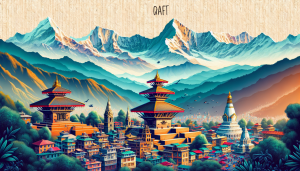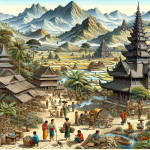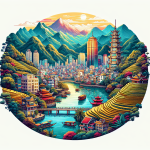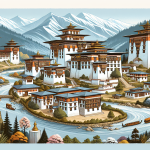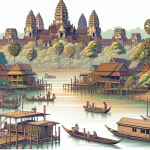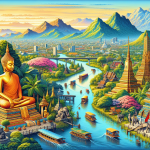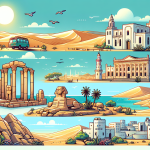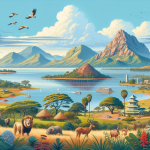Nepal: A Journey Through the Land of Himalayas and Rich Culture
Nepal, a small yet incredibly diverse country in South Asia, is renowned for its stunning landscapes, rich culture, and warm hospitality. Nestled between the giants of China and India, Nepal offers a unique blend of natural beauty and cultural richness that attracts travelers from all around the globe. From the towering peaks of the Himalayas, including the world’s highest mountain, Mount Everest, to the lush lowlands of the Terai, the country’s geography is as varied as its culture. Not only is Nepal a haven for trekkers and mountaineers, but it also boasts a wealth of historical and cultural sites, including several UNESCO World Heritage Sites. The Kathmandu Valley, with its ancient temples and vibrant festivals, provides a glimpse into the country’s rich heritage. This guide delves into what makes Nepal a must-visit destination, exploring its natural wonders, cultural treasures, and practical travel tips to help you plan an unforgettable journey.
The Natural Beauty of Nepal
Nepal’s natural beauty is truly extraordinary, making it a top destination for nature lovers and adventure enthusiasts. The country’s diverse landscape ranges from the towering peaks of the Himalayas to the lush plains of the Terai, offering something for everyone. **Mount Everest**, known locally as Sagarmatha, is a major draw for trekkers and climbers from all over the world. The Everest Base Camp trek is one of the most popular routes, offering breathtaking views and a challenging adventure. Besides Everest, the Annapurna Circuit and the Langtang Valley are also famous trekking destinations, each providing unique experiences and stunning scenery.
For those who prefer a more relaxed approach to nature, Nepal’s national parks and wildlife reserves offer excellent opportunities for wildlife viewing and nature walks. **Chitwan National Park** and **Bardia National Park** are home to a variety of wildlife, including the endangered one-horned rhinoceros, Bengal tigers, and a plethora of bird species. The lush jungles and serene rivers of these parks provide a tranquil escape from the hustle and bustle of city life.
The pristine lakes of Nepal are another highlight. **Pokhara**, often referred to as the “Gateway to the Himalayas,” boasts the beautiful Phewa Lake, where travelers can enjoy boating and take in the reflection of the Annapurna range on the water’s surface. **Rara Lake**, the largest lake in Nepal, offers a more remote and peaceful experience, surrounded by pine forests and snow-capped mountains.
Cultural Richness and Heritage
Nepal’s cultural richness is as impressive as its natural beauty. The country is home to a diverse population with over 100 ethnic groups, each with its own language, customs, and traditions. This cultural mosaic is reflected in Nepal’s festivals, architecture, and daily life, providing a vibrant and colorful backdrop for visitors.
Kathmandu Valley
The **Kathmandu Valley** is the cultural and historical heart of Nepal. This UNESCO World Heritage Site comprises three main cities: Kathmandu, Patan, and Bhaktapur, each with its own unique charm and historical significance. **Kathmandu**, the capital city, is a bustling metropolis where ancient traditions and modern life coexist. The city’s narrow streets are lined with ancient temples, markets, and traditional homes. **Durbar Square**, a complex of palaces, courtyards, and temples, is a must-visit site in Kathmandu. Other notable attractions include the **Swayambhunath Stupa** (also known as the Monkey Temple), and the **Pashupatinath Temple**, one of the holiest Hindu temples in the world.
**Patan**, also known as Lalitpur, is renowned for its artistic heritage and exquisite craftsmanship. The city’s **Durbar Square** is a UNESCO World Heritage Site, home to a stunning collection of temples, statues, and palaces. Patan is also famous for its traditional Newari architecture, intricate wood carvings, and metalwork.
**Bhaktapur**, another UNESCO World Heritage Site, is a living museum of medieval art and architecture. The city’s well-preserved palaces, courtyards, and temples provide a glimpse into Nepal’s rich history. Bhaktapur is also known for its pottery and traditional crafts, with many artisans still practicing their trades in the city’s narrow alleys.
Festivals and Traditions
Nepal’s festivals and traditions are a reflection of its diverse culture and religious heritage. The country celebrates a myriad of festivals throughout the year, each with its own unique customs and rituals. **Dashain**, the longest and most important festival in Nepal, celebrates the victory of good over evil and is marked by family gatherings, feasts, and religious ceremonies. **Tihar**, the festival of lights, is another major celebration, where homes are decorated with oil lamps and colorful rangolis.
**Holi**, the festival of colors, is a joyous celebration marked by the throwing of colored powders and water. This festival, which signifies the arrival of spring, brings people together in a vibrant display of unity and happiness. **Teej**, a festival celebrated by Nepali women, is dedicated to the goddess Parvati and involves fasting, dancing, and singing traditional songs.
Practical Travel Tips for Nepal
Traveling to Nepal requires some preparation, but the rewards are well worth the effort. Here are some practical tips to help you plan your trip:
Best Time to Visit
Nepal has a diverse climate, with varying weather conditions depending on the region and altitude. The best time to visit Nepal is during the **autumn (September to November)** and **spring (March to May)** seasons. During these times, the weather is generally clear and mild, making it ideal for trekking and outdoor activities. The autumn season is particularly popular for trekking, as the skies are clear, and the mountain views are spectacular. Spring is also a great time to visit, with blooming rhododendrons adding a splash of color to the landscape.
Visa and Entry Requirements
Most travelers to Nepal will need a visa, which can be obtained on arrival at Tribhuvan International Airport in Kathmandu or at various land border crossings. Tourist visas are available for 15, 30, and 90 days, with the option to extend your stay if needed. Be sure to check the latest visa requirements and regulations before you travel.
Health and Safety
When traveling to Nepal, it’s essential to take some basic health and safety precautions. Make sure you are up to date on routine vaccinations, and consider getting additional vaccinations for diseases such as hepatitis A, typhoid, and rabies. Altitude sickness can be a concern if you plan to trek in the higher regions, so it’s important to acclimatize properly and be aware of the symptoms. Drinking bottled or purified water and practicing good hygiene can help prevent common illnesses such as travelers’ diarrhea.
Transportation and Getting Around
Nepal’s transportation infrastructure can be challenging, but there are several options for getting around the country. Domestic flights are available between major cities and popular trekking destinations, offering a convenient and time-saving option. Buses and minibusses are the most common form of public transportation, but they can be crowded and less reliable. For shorter distances, taxis and rickshaws are readily available in urban areas. In more remote regions, trekking is often the best way to explore the landscape and reach your destination.
Adventure Activities in Nepal
Nepal is synonymous with adventure, offering a wide range of activities for thrill-seekers and outdoor enthusiasts. From trekking and mountaineering to white-water rafting and paragliding, there is no shortage of adrenaline-pumping experiences to be had in this beautiful country.
Trekking and Mountaineering
Trekking is one of the most popular activities in Nepal, with routes ranging from easy walks to challenging high-altitude treks. The **Everest Base Camp trek**, **Annapurna Circuit**, and **Langtang Valley trek** are among the most well-known and rewarding treks in the country. These treks offer stunning views of the Himalayas, diverse landscapes, and the opportunity to immerse yourself in the local culture. For those seeking an even greater challenge, Nepal is home to eight of the world’s fourteen highest peaks, including Mount Everest, making it a premier destination for mountaineers.
White-Water Rafting and Kayaking
Nepal’s rivers provide excellent opportunities for white-water rafting and kayaking, with routes suitable for all levels of experience. The **Trisuli River**, **Seti River**, and **Bhote Koshi River** are popular choices for rafting trips, offering a mix of exciting rapids and beautiful scenery. Multi-day rafting expeditions, such as those on the **Karnali River** and **Sun Koshi River**, offer a more immersive experience, allowing you to explore remote regions and camp along the riverbanks.
Paragliding and Other Aerial Adventures
For a bird’s-eye view of Nepal’s stunning landscapes, try paragliding in **Pokhara**, one of the world’s top paragliding destinations. The experience of soaring above the lakes and mountains is truly unforgettable. Other aerial adventures include **ultralight flights** and **hot air ballooning**, both of which provide a unique perspective of the country’s natural beauty.
Culinary Delights of Nepal
Nepali cuisine is a delicious fusion of flavors and influences, reflecting the country’s diverse cultural heritage. From hearty traditional dishes to mouthwatering street food, there is something to satisfy every palate in Nepal.
**Dal Bhat**, the national dish, is a staple of Nepali cuisine, consisting of rice, lentil soup, and a variety of side dishes such as vegetables, pickles, and curries. This wholesome and nutritious meal is enjoyed by locals and visitors alike. **Momo**, Nepali dumplings, are another popular dish, often filled with meat or vegetables and served with a spicy dipping sauce. **Chatamari**, sometimes referred to as “Nepali pizza,” is a traditional Newari dish made from rice flour and topped with a variety of ingredients such as minced meat, eggs, and vegetables.
Street food is an integral part of the culinary experience in Nepal, with vendors offering a wide range of tasty and affordable snacks. Some must-try street foods include **samosas**, **pani puri**, and **sel roti**, a traditional Nepali doughnut made from rice flour. For those with a sweet tooth, **jerry** (similar to jalebi) and **lal mohan** (a type of sweet dumpling) are popular treats.
Responsible Travel in Nepal
As a responsible traveler, it’s important to consider the impact of your visit on the local environment and communities. Here are some tips for practicing sustainable and responsible travel in Nepal:
1. **Respect local customs and traditions**: Nepal is a culturally diverse country with a rich heritage. Be mindful of local customs and traditions, dress modestly, and show respect for religious sites and practices.
2. **Support local businesses**: Choose locally-owned accommodations, restaurants, and tour operators to help support the local economy. Purchase souvenirs and handicrafts from local artisans to contribute to their livelihoods.
3. **Reduce your environmental impact**: Minimize waste by carrying a reusable water bottle, avoiding single-use plastics, and properly disposing of your trash. When trekking, stick to established trails and camp only in designated areas to protect the fragile environment.
4. **Give back to the community**: Consider volunteering with local organizations or participating in community-based tourism projects that benefit the local population. Your time and effort can make a positive difference in the lives of the people you meet.
By following these tips, you can help ensure that your visit to Nepal is not only enjoyable but also beneficial to the local environment and communities.
Conclusion
Nepal is a land of unparalleled natural beauty, rich cultural heritage, and endless adventure opportunities. Whether you’re seeking the thrill of trekking in the Himalayas, exploring ancient temples and historical sites, or simply immersing yourself in the local culture, Nepal has something to offer every traveler. With its warm hospitality and diverse experiences, a visit to Nepal is sure to leave you with lasting memories and a deep appreciation for this incredible country. So pack your bags and get ready to embark on a journey of a lifetime in the enchanting land of Nepal.
For more information on planning your trip to Nepal, visit the official website of the **Nepal Tourism Board** [here](https://www.welcomenepal.com).
